-

From the fall of Atlantis...
-
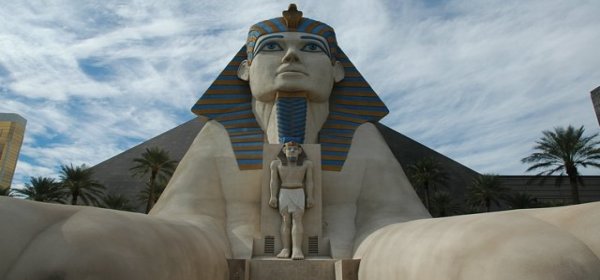
To a forgotten past...
-

Clues in ancient maps...
-
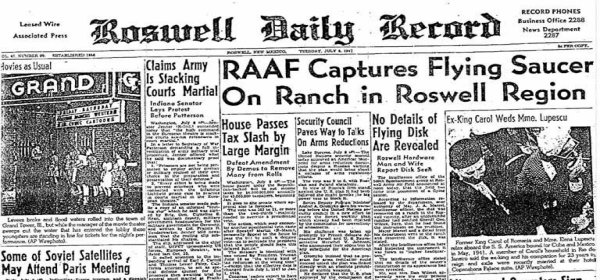
And accidental revelations...
-

The post war truth revealed...
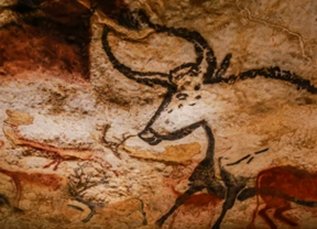
We popularly imagine our ancient ancestors as primitives,
scratching out a living from cold barren caves, preying on unsuspecting animals
for food that is then roasted over man's greatest discovery, fire. The more mentally agile, may even throw in a scantily dressed Racquel Welsh look-a-like poised up a tree as a Tyrannosaurus Rex thunders by. (Political and historical correctness, of course, did not exist
then.) Yet 'ice-age' man was far from the primitive we popularly
conceptualize. We know this from paintings he has left behind in caves such as
these at Lascaux in France, (above), and from other evidence. One such piece of evidence had lain
forgotten in a dim corner of a French museum. Then in 1965 a researcher examined
this fragment of a carved reindeer bone. Under a microscope a pattern could be
discerned, a pattern which appeared to represent the phases of the moon over a
period of two months (below). Shack, the person who made the discovery, recalls the find.
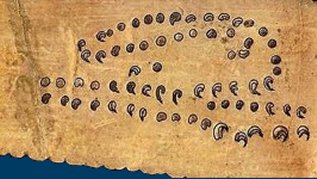
"Whether or not the image is accepted as lunar, as it seems to be, I had
discovered the earliest known human notation, made more than twenty thousand
years before the development of writing, arithmetic, or the calendars of later
cultures we regard as civilized. Gradually the bone told me a great deal about
the skills of its owner, and how he may have thought. Patterns of wear identify
it as a pressure flaker, a kind of prehistoric machine tool, used to shape stone
instruments.
The man who made and carried it over
a considerable period, also used it as a notebook, apparently to record an
important sequence in his everyday life, the changing moon that marked the
passing seasons." (9)
This find was remarkable for it suggested that Cro-Magnon man thought in a far
more sophisticated way than was believed possible. Up to the discovery of the
reindeer bone, all that was known about Cro-Magnon man was pieced together from
archaeological remains. These were first discovered in France in 1868. Hundreds
of thousands of his stone tools have subsequently been found as have painted
images in caves in south-western France and northern Spain.
The reindeer bone
was found in 1911 by a French archaeologist Louis Didon in the
Blanchard rock shelter near the French village of Les Eyzies. Shack decided to investigate Cro-Magnon man further with a view
to shedding further light on his culture. From a base in Les Eyzies, he
journeyed across Europe examining thousands of Ice Age artifacts and engravings.
Shack wasn't particularly interested in the physical aspects of Cro-Magnon man,
but rather "those fragile and subtle clues as to how he thought." (10) Shack concluded that Cro-Magnon man was remarkably
sophisticated. No, he did not have electric kettles, mobile phones (or nuclear
waste), but he had a skeleton and brain like modern man's and was capable of
imagery and abstract thought.
Seventeen thousand years after
Cro-Magnon man populated Europe, his world began to melt around him signalling
the ending of the last ice-age.
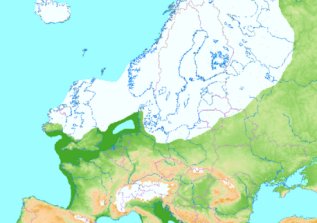
Great glaciers retreated towards the poles and this process lasted until around
7500 BCE, destroying many land bridges in its wake and finally separating the
British Isles from mainland Europe, leaving many forests across the globe
submerged. (Above image of Europe at the time of the last ice-age.) Then during this period, 12,000 years ago, there began the
Mesolithic or Middle Stone Age in northern Europe; a food-gathering way of life
with fishing and fowling rather than wide-range hunting. The age produced some important inventions such as the barbed
fishhook, the bow and arrow, the cooking pot of baked clay, and perhaps most
importantly, the comb! Within 4000 years the Neolithic age arrived, representing a
change from living on nature to co-operating with nature. It depended on two
fundamental inventions; the domestication of animals and the
cultivation of crops. This way of life produced new flint tools; the sickle, the
hoe and a better made axe.
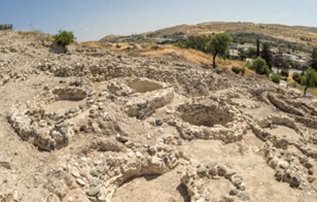
There is also evidence that mankind was beginning to
navigate on the open sea as this Neolithic settlement (above) is to be found at Khirokitia on the island of Cyprus. And then in 6800 BCE there is evidence of Neolithic people
settling at the site of Jericho, with houses and a protective wall, suggestive
of organised raiding and warfare. At about the same
time, a village appears on a tributary of the Upper Tigris at Jarmo where there are also houses made from
pressed earth with reed floors. The area between the river Tigris and the Euphrates was
extremely fertile and attracted the people we call Sumerians to settle there.
Then by 3000 years ago cities had grown around the rivers Tigris and Euphrates.
Some of these, such as Ur, Nippur and Eridu had thousands of inhabitants. Groups of hunters had, by this time, moved into the Nile valley
where they found an abundance of animals, birds and fish, but more importantly,
a reliable and plentiful source of clean water in the River Nile. The farmers eventually joined together to form two kingdoms,
Upper (southern) Egypt and Lower (northern) Egypt. In 3100BCE a king, seemingly
named Namer by hieroglyphics but traditionally known as Menes, advanced from his
southern capital of Abydos and conquered the Lord of the Delta Land and created
the First Dynasty of the combined Old and New Kingdoms of Egypt (11). Once the two
kingdoms were joined, Egyptian culture flourished until they came up against the
seemingly invincible Roman Empire. In more remote areas of Europe megaliths had appeared
apparently to indicate where on the horizon the Sun and Moon will rise and set
at special times throughout the year. This monument (below) is part of the thirty-eight stones that form a circle at Castlerigg in England. Legend states that the stones are men petrified by the Gods and now serve as
astronomical markers.

These cultures seemed far removed from the high
technologies and mathematical excellence used in the construction of the
pyramids, the Sphinx and the city of Tiahuanaco apparently thousands of years before man built his mud-huts in
Jericho and positioned these ancient megaliths.
Indeed this accepted view of world history simply cannot
account for the planet's real history. It therefore appears that our view of
world history is in need of some revision and the possible extent of how much
revision was revealed in the early years of the Twentieth Century when a violent
flood tore through the Paluxy River Valley in Glen, Close, Texas. What it
revealed was startling.
References
(1) Whitfield, Philip, The Natural History of Evolution p.11 Marshall Editions, 1993.
(2) Ibid
(3) Dennett, D., Darwin's Dangerous Idea, pp 292 & 296., Penguin 1995.
(4) Dawkins p. 8
(5) Whitfield, Philip, The Natural History of Evolution p.44 Marshall Editions, 1993.
(6) Bronowski, J., The Ascent of Man Book Club Associates, London 1977.
(7) Ibid p. 28.
(8) Whitfield, Philip, The Natural History of Evolution p.44 Marshall Editions, 1993.
(9) Nat Geo Jan 1975 Exploring the Mind of Ice-Age Man p65-66.
(10) Ibid p. 67.
(11) Mellersh, H. E. L., The Ancient World 10,000BC - AD799 p. 8, Helicon Publishing Ltd., Oxford, 1976.
Explore forgotton clues scattered throughout history that are suggestive
of an alternative history.
Join the world-wide search for evidence
of a lost civilisation that predates
known history.
Has Earth already been contacted by other civilisations either in the distant past or in recent centuries?
A discussion of the emergence of advanced technologies and the bizarre invasion of Antarctica after WWII.
A discussion of sightings of UFOs in the sky above Earth and within the solar system, including Moon anomalies.
Evidence the Earth has been visited by extraterrestrials and how the public had been subject to disinformation.
A list of credits and sources for the themes and issues explored
in Violations.
Violations is now available to purchase in
paperback or Kindle versions complete
with exclusive additional content!